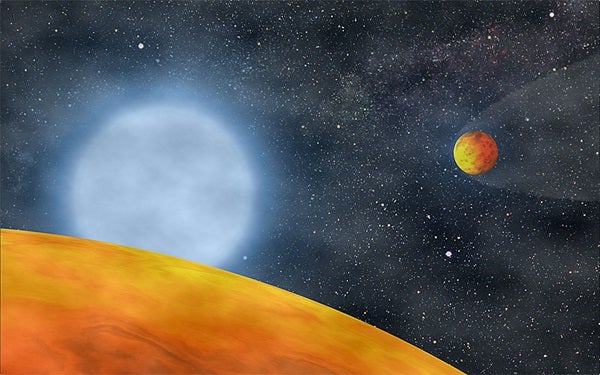Steve Kawaler from Iowa State University helped the research team study data from the Kepler space telescope to confirm that tiny variations of light from a star were actually caused by two planets orbiting it. Stéphane Charpinet from the Institut de Recherche en Astrophysique et Planétologie in Toulouse, France, is the leader of the research team.
“This is a snapshot of what our solar system might look like after several billion more years of evolution,” Kawaler said. “This can help us learn about the future of planetary systems and of our own Sun.”
Kawaler said the researchers have studied pulsations of the planets’ host star, KIC 05807616 — an old star just past its red-giant stage — for about two years. While analyzing the data, Charpinet noticed two tiny variations repeated in 5.76- and 8.23-hour intervals.
He asked other astronomers, including Kawaler, to analyze the original Kepler data and a subsequent set of data to see if they also could see the variations.
“We saw them in the same place and the same periodicity,” Kawaler said. “So we knew they were real.”
That led to the next question: “So what are they?”
Kawaler has studied the fastest and slowest rates that stars could pulsate. Using that result, the team could conclude the variations seen by Kepler were too slow to be from the star itself. So the astronomers started testing the idea that the variations were from two planets orbiting the star.
Astronomers believe the variations from the two planets, KOI 55.01 and KOI 55.02, are caused by reflection of the star’s light on the planets and by temperature differences between the hot day-sides and cooler night-sides of the planets.
The astronomers also report the planets are 76 percent and 87 percent the size of Earth. That makes them among the smallest planets detected around a star other than our Sun.
They further report the planets are close to their host star, only 0.6 percent and 0.76 percent the distance between the Sun and Earth. That means conditions on the planets are harsh with temperatures up to 16,000° Fahrenheit (9,000° Celsius).
That’s so close that the host star’s expansion to a red giant would have engulfed the planets, possibly stripping gas giant planets similar to Jupiter down to their dense cores. The planets also could have contributed to the host star’s unusual loss of mass.
The research team said the discovery of the two planets raises many questions about their ability to survive such harsh conditions. It also raises questions about how planets can affect the evolution of their host stars.
Steve Kawaler from Iowa State University helped the research team study data from the Kepler space telescope to confirm that tiny variations of light from a star were actually caused by two planets orbiting it. Stéphane Charpinet from the Institut de Recherche en Astrophysique et Planétologie in Toulouse, France, is the leader of the research team.
“This is a snapshot of what our solar system might look like after several billion more years of evolution,” Kawaler said. “This can help us learn about the future of planetary systems and of our own Sun.”
Kawaler said the researchers have studied pulsations of the planets’ host star, KIC 05807616 — an old star just past its red-giant stage — for about two years. While analyzing the data, Charpinet noticed two tiny variations repeated in 5.76- and 8.23-hour intervals.
He asked other astronomers, including Kawaler, to analyze the original Kepler data and a subsequent set of data to see if they also could see the variations.
“We saw them in the same place and the same periodicity,” Kawaler said. “So we knew they were real.”
That led to the next question: “So what are they?”
Kawaler has studied the fastest and slowest rates that stars could pulsate. Using that result, the team could conclude the variations seen by Kepler were too slow to be from the star itself. So the astronomers started testing the idea that the variations were from two planets orbiting the star.
Astronomers believe the variations from the two planets, KOI 55.01 and KOI 55.02, are caused by reflection of the star’s light on the planets and by temperature differences between the hot day-sides and cooler night-sides of the planets.
The astronomers also report the planets are 76 percent and 87 percent the size of Earth. That makes them among the smallest planets detected around a star other than our Sun.
They further report the planets are close to their host star, only 0.6 percent and 0.76 percent the distance between the Sun and Earth. That means conditions on the planets are harsh with temperatures up to 16,000° Fahrenheit (9,000° Celsius).
That’s so close that the host star’s expansion to a red giant would have engulfed the planets, possibly stripping gas giant planets similar to Jupiter down to their dense cores. The planets also could have contributed to the host star’s unusual loss of mass.
The research team said the discovery of the two planets raises many questions about their ability to survive such harsh conditions. It also raises questions about how planets can affect the evolution of their host stars.










